Uncategorized
NASTT turns 25 in 2015! What was happening 25 years ago?
On June 28, 1990, Susan Lucci loses the Daytime Emmy Award for the 11th time.
On June 30, 1990, East & West Germany merge their economies.
On July 4, 1990, 400 New Kids on the Block fans treated for heat exhaustion in Minnesota.
Check in every Friday in 2015 when NASTT posts more fun facts about 25 years ago…
Uncategorized
Drill sets industry standard for productivity, reliability and quiet operation
PELLA, Iowa — The Vermeer D23x30 S3 Navigator® horizontal directional drill (HDD) packs 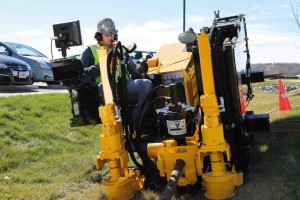 speed and power into a shorter, narrower design to help increase productivity when working in urban areas or compact jobsites. With 24,000 pounds (106.8 kN) of thrust and pullback and 3,000 foot-pounds (4,068 Nm) of rotational torque — an impressive increase over its predecessor, the D20x22 Series II Navigator HDD — the D23x30 S3 is equipped to maximize machine and jobsite efficiency.
speed and power into a shorter, narrower design to help increase productivity when working in urban areas or compact jobsites. With 24,000 pounds (106.8 kN) of thrust and pullback and 3,000 foot-pounds (4,068 Nm) of rotational torque — an impressive increase over its predecessor, the D20x22 Series II Navigator HDD — the D23x30 S3 is equipped to maximize machine and jobsite efficiency.
Speed, simplicity and sound are the trademarks of the Vermeer S3 generation of directional drills. Each S3 model has been redesigned by listening to customer input to achieve sound reductions, enhanced speed and a simplified design.
The D23x30 S3 offers significant gains in sound reduction making it well-suited to working in congested commercial and residential areas, as the quieter working environment makes for less neighborhood disturbance. With a 99 dBA guaranteed sound power level and an operator ear rating of 78.7 dBA, the D23x30 S3 is one of the quietest drills on the HDD market.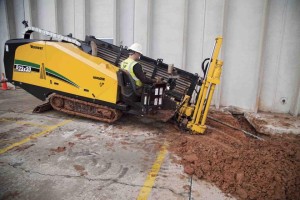
A carriage speed of 206 feet per minute (62.8 m/min), and a rotational speed of 219 rpm — which rivals larger drills — and enhanced rod breakout efficiency will help contractors install more linear feet per day. The D23x30 S3 also offers a ground tracking speed of up to 3.3 mph (5.3 km/h) to help contractors get from one project to another faster.
To power the D23x30 S3, Vermeer has selected a 100-horsepower (75 kW), liquid-cooled, turbocharged diesel Deutz TCD 3.6L4 Tier 3/Tier 4-compliant engine, which is capable of producing greater power than its predecessor.
“The D23x30 S3 is the ideal drill for utility installations up to 6 inches (12.2 cm) in diameter and in compact or congested areas,” said Jon Kuyers, senior global product manager, underground, for Vermeer. “The D23x30 S3 helps address today’s operational challenges and provides a low cost of operation due to its power-to-footprint ratio.”
A common control system currently used on the larger Navigator drill lineup is featured on the D23x30 S3 drill. This includes a digital display, improved onboard diagnostics and common joystick controls. The system design uses a power distribution module that reduces the amount of wiring and fuses for greater reliability. All S3 Navigator drills have a common control platform, assisting drill operators in operating a variety of S3 drill models and lessening the time needed for training.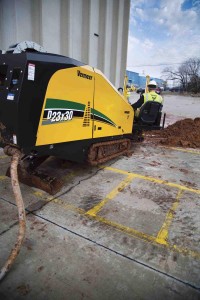
An onboard self-diagnostic system empowers contractors to make machine adjustments when required and helps to maximize productivity. The Vermeer InSite™ Fleet remote monitoring system is optional on the D23x30 S3. InSite Fleet is available now.
Contractors have two 10-foot (3 m) Firestick® drill stem options to configure the drill for different types of work — for longer runs, a 2.06-inch (5.2 cm) diameter drill stem is available and provides improved flexibility in tight bore requirements. When pulling back larger product or for compatibility with rock tooling, contractors can select a 2.375-inch (6 cm) diameter drill stem that offers a better flow path for improved air hammer efficiency and flexibility for rock drilling applications.
Improved rotation, thrust and tracking performance is the result of an enhanced hydraulic system that helps to increase the system’s efficiency, allowing better use of engine horsepower and increasing the drill’s productivity.
Daily maintenance has been simplified with all service points located on one side of the drill and easily accessed via a rugged hood design.
The D23x30 S3 directional drill is now available through the Vermeer global dealer network. For more information on Vermeer products and services, visit the company’s website at www.vermeer.com or email Vermeer at salesinfo@vermeer.com.
Vermeer Corporation delivers a real impact in a progressing world through the manufacture of high-quality underground construction, surface mining, tree care, environmental and agricultural equipment. With a reputation for durability and reliability, that equipment is backed by localized customer service and support provided by independent dealers around
the world. To learn about Vermeer Corporation, products, the dealer network and financing options, visit vermeer.com.
Vermeer, the Vermeer logo, Equipped to Do More, Navigator and InSite are trademarks of Vermeer Manufacturing Company in the U.S. and/or other countries.
© 2015 Vermeer Corporation
All Rights Reserved.
Please send all reader inquiries to:
Vermeer Corporation
P.O. Box 200
Pella, Iowa 50219
+1-641-628-3141
Uncategorized

Tri-State Utilities – Chesapeake, Virginia – This September will be the 25th Anniversary of Tri-State Utilities! In addition, this April marked the 15 year anniversary of the licensee agreement between Tri-State Utilities and CIPP Corp. It is amazing how fast that 15 years has passed us by and the changes, or evolution if you will, that has occurred within the CIPP industry. When we first began installing CIPP liners, it was out of necessity. The PVC Fold & Form market was drying up due to poor product performance by the HDPE Fold & Form products, patent infringement lawsuits by Insituform against Fold & Form manufacturers, and the use of steam to effectively cure CIPP liners. The latter being the reason for the unprecedented growth of the rehabilitation market not only in the United States, but around the world.
We began installing CIPP liners very modestly, one water cure crew slowly but surely installing liners daily ranging in size from 6” to 48” diameter. We would drive 14 hours every other week to Columbus, Ohio or Hudson, Iowa to pick up our wet-out liners for the first two years of operation. Within the first 18 months of installing CIPP liners, we quickly realized we could use the same equipment we were processing Fold & Form liners with to cure the CIPP and with that decision came a very fast growth to five CIPP crews and almost two million feet of CIPP installed over the past 15 years.
As exciting as the past 15 years of CIPP lining have been, we feel that the next 15 years are going to be even better. The CIPP industry is continuing to evolve; in the very near future applying CIPP liners to pressure pipes both potable and sanitary will become accepted practice. The application of CIPP to pressure pipes will allow for a greater amount of pipe to be rehabilitated in the country at a fraction of today’s replacement cost. This is a win for all parties involved; we (citizens) will enjoy cleaner drinking water and better sanitation and utility owners will reap the benefit of lowered rehabilitation costs.
All of this change is possible by the creativity and ingenuity of our industry professionals. Whether by water, steam or UV cure, Polyester Felt, Glass Reinforced, or other exotic material, our industry is moving forward every year with new and improved variations of the same “old” thing: Cured-In-Place Pipeliner!
We at Tri-State Utilities look forward to bringing our customers new and innovative products such as the Rausch Quicklock Repair Sleeve, the Link-Pipe Repair Sleeve, pressure pipe liners, and short liners.
We also want to thank our customers for trusting us to bring them the best product the industry can offer for 25 years and offer a special thanks to Steven F. McSweeney for providing us with a great place of employment and example of how to carry ourselves.
Uncategorized
by Tom Damm
Transforming lives is something Sarah’s Hope in Baltimore does every day as an emergency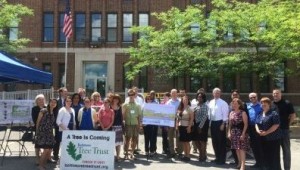 homeless shelter for families.
homeless shelter for families.
But this week, the focus at the safe haven was on a different type of transformation: replacing the asphalt and concrete on the property with an environmentally friendly community green space and outdoor playground area.
Earlier this week, EPA Regional Administrator Shawn M. Garvin was at Sarah’s Hope to join partners in announcing funding for a key phase of the project.
A $75,000 grant from the Green Streets, Green Jobs, Green Towns (G3) program will be used to tear up the hard surfaces in front of the property that during storms send rain water rushing into the street and drains, leading to flooding and pollution problems. The surfaces will be replaced with lawn, shade trees, native plants, and other green features that will let the rain soak in and provide a welcome lift to this troubled neighborhood.
The atmosphere at the event was upbeat as the project partners, Parks & People Foundation, the City of Baltimore and St. Vincent de Paul, described their plans for the facility.
The G3 grant will tie into a larger Baltimore City project to create public open space, a playground area and a community garden at the site, which is now almost fully covered with impervious surface. The work will improve the property for shelter residents and the community at large, and transform the appearance of the Sandtown-Winchester neighborhood.
Many of the other grantees were also on hand at the event to talk about how the G3 funds will help expand urban tree canopies, create bioretention cells to capture stormwater, and install other types of green infrastructure in neighborhoods in Maryland, Pennsylvania, and Virginia.
By keeping rain water from coming into contact with pollution in the first place, green infrastructure improves the health of our waters, while effectively reducing flooding, and helping our communities adapt to the very real challenges of climate change.
The G3 program – sponsored by EPA, and the Chesapeake Bay Trust, with assistance from the Maryland Department of Natural Resources – is in its fifth year. In this latest round of grants, 15 recipients will share in more than $727,000 in funding – bringing the total aggregate investment in G3 grants to more than $11 million when matching funds are included over the five-years that the program has been in existence.
About the Author: Tom Damm has been with EPA since 2002 and now serves as communications coordinator for the region’s Water Protection Division.
Photo Caption:
EPA, the Chesapeake Bay Trust and MD DNR announced $727,500 in grants to 15 organizations via the Green Streets, Green Towns, Green Jobs Grant Initiative
Source: https://blog.epa.gov/blog/2015/06
Uncategorized

NASTT turns 25 in 2015! What was happening 25 years ago?
On June 22, 1990, Adam Sandler joined the cast of “Saturday Night Live”.
On June 23, 1990, TV Guide selected Arsenio Hall as TV personality of year.
On June 26, 1990, it was 122°F in Phoenix, Arizona! That’s HOT!
Check in every Friday in 2015 when NASTT posts more fun facts about 25 years ago…
Uncategorized
In underground construction, you pretty much expect the unexpected.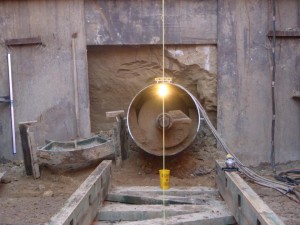
So it wasn’t a shock when an auger boring crew from Nix Construction hit … something that stopped them cold even though they’d just successfully completed a bore using a pilot tube system in the other direction on a job near Salt Lake City last December.
But it was a mystery, at least at first.
“The best way I can explain it is we ran out of jacking force,” says Jon Nix, vice president and COO of the family-owned company. “The auger boring machine operator maxed out the machine, and that piece of equipment is 200,000 pounds of jacking force. The refusal wouldn’t let the head push off from side to side. It just pinned it and held it.”
The job was for the South Valley Sewer District, which provides public sanitary sewer service in the Salt Lake City area. It called for approximately 2,300 feet of 18-inch SDR 35 PVC sewer pipe to be installed under a divided freeway. The PVC pipe was to be housed in 509 feet of 30-inch steel casing, which Nix Construction was subcontracted to install.
Utah-based Nix Construction planned for two bores, one in each direction under the road. The design slope for the sewer line was 0.3 percent.
Auger boring is a popular method for jobs like this, where precision with the line and grade are critical. It’s also a good approach when product needs to be installed under a road or railroad because there is minimal road upheaval and soil subsidence.
It turns out the Nix Construction crew hit what Jon Nix describes as a “massive amount of rock.” Once they got boring again, 6-to-8-inch chunks of cobble were coming out of the discharge on the auger boring machine.
To get through it, Nix rented an On Target steering system from McLaughlin. With it, the steering head can be kept on the proper cutting path with hydraulic actuated flaps that open and close, allowing for lateral movement. The On Target system’s active cutter head was what helped Nix Construction the most.
The cutter head fits on the lead end of the casing and is the same diameter as the pipe being installed. That allows for the ability to swallow larger stones and ingest material through the throat of the steering head, which is augered back to the bore pit. In comparison, with the pilot tube system the company typically uses, soil is displaced using thrust force on the drill string relying on material to be compacted to the sides of the head.
A positive experience with the On Target system several years before left Nix confident it’d work on this job, allowing him to kick the “expect the unexpected” maxim for that part of the bore.
“We had a pretty good feeling that even when we hit the refusal that we could get the job done and take care of the client,” Nix says.
For more information about the On Target steering system and McLaughlin, visit www.mclaughlinunderground.com or call (864) 277-5870. Check out the company on Facebook at www.facebook.com/mclunderground.







